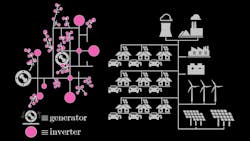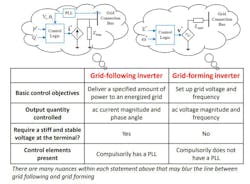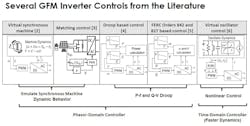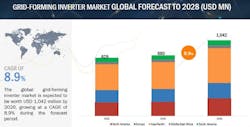Grid-Forming Inverters: The Missing Ingredient for Sustainable Power Grids?
Members can download this article in PDF format.
What you’ll learn:
- How grid-forming inverters can help utilities incorporate much larger percentages of renewable energy into their energy portfolios.
- How recent efforts at standardization and interoperability will accelerate the use of grid-forming inverters within the utility sector.
- Why the $680M market for grid-forming inverters is expected to enjoy a CAGR of nearly 9% for the next five years or more.
Despite the challenges it's creating for some existing industries, the transition to a sustainable economy is in the process of hundreds of billions of dollars in new opportunities for products that will enable a low-carbon energy infrastructure.
While the equipment employed to generate wind, solar, and other renewable-energy sources are the most obvious beneficiaries of the "Green Boom,” the products and technologies used to store, manage, and deliver that power are also in great demand. This includes so-called "grid-forming inverters (GFIs)," a special type of inverter that can provide existing electrical generation and distribution networks with distributed regulation capabilities. They enable these networks to work more efficiently with the rapidly varying power levels that can sometimes occur in wind and solar farms.
Following vs. Forming Inverters
Virtually all of today's installed wind and solar power farms, and their accompanying battery storage systems that are connected to a larger power distribution network, use "grid-following" inverters. These measure the grid's AC voltage waveform and inject the current levels needed to synchronize the local source with it. This is because utilities have relied primarily on the rotational inertia of their mechanical generating equipment to stabilize the grid.1
Large synchronous machines have sometimes been used to provide power factor correction (PFC) at some problematic load points. However, their high cost means that the centralized generating equipment itself must provide virtually all of the stabilization.
The inverters used in virtually all of today's renewable generating assets are phase-locked-loop controlled current sources, designed to increase or decrease their output based on the primary grid's voltage and phase angle.3
While this approach works well under normal conditions, it requires that the grid must be online to provide its "heartbeat" waveform required by the inverter to synchronize its output. This means that even though a solar or wind farm might be fully functional during a technical problem or natural disaster, grid operators must first bring a conventional energy source, like a coal or natural gas plant, back on line before the renewable sources, or their storage systems, can be accessed.
In contrast, “grid-forming” technology refers to a control paradigm in which the inverter synthesizes a voltage phasor that’s controlled relative to the grid’s voltage phasor to achieve the desired current and power flow.2
As a result, GFIs can interact with the grid by sensing changes in its amplitude and frequency, and then respond in real-time to adjust its output frequency by injecting more or less power as needed to stabilize the entire network. This allows GFIs to help power grids accommodate the constantly varying outputs of wind and solar farms.
And, since GFIs can synthesize their own output waveforms, they’re able to operate in standalone mode if the grid they’re attached to should fail. This makes them an excellent building block for creating highly resilient "microgrids," defined as a group of interconnected loads and distributed energy resources that appears to the grid as a single controllable entity.
Their grid-forming properties allow them to operate as part of a larger generation/distribution grid, or disconnect and operate in so-called "island mode." Thus, they can be independently restarted when a natural disaster or some other calamity brings down the larger network. Devolving control of the grid's now-centralized regulation functions into a distributed, interactive architecture would enable still-functioning generating assets to continue to deliver power during widespread outages, and speed recovery to normal operation.
Challenges with GFIs and Microgrid Adoption
GFI technology has been used in standalone microgrid applications (not tied to a primary grid) for a decade or more, with a growing number of successful installations in Europe, the Caribbean, Australia, Asia, and the U.S. But a number of issues remain before integrating large numbers of microgrids and other distributed generating resources into large power grids is practical. Part of the difficulty is that, until now, no standards or guidelines govern the design, function, and operation of GFIs.4
The U.S. Department of Energy (DoE) has begun to tackle this problem with a $25 million initiative aimed at overcoming the issues that have made it difficult to adopt grid-forming inverters into the U.S. power system. Now in its second year of operation, a consortium, led by the National Renewable Energy Laboratory known as UNIFI, for “universal interoperability for grid-forming inverters,” has focused on fundamental issues, such as interoperability, reliability, and providing a roadmap for integrating the technology into existing infrastructures.5
That includes a set of guidelines on how GFIs should interact with the power grid, and each other. UNIFI already released a set of draft standards in late 2022, intended as the first step toward a national grid code that includes technical specifications GFI for equipment and related technologies. Release of a second, updated version is anticipated for the end of 2023.1
To better inform its efforts, UNIFI purchased a representative sampling of grid-forming inverters from several manufacturers and ran an extensive series of performance and interoperability tests on them at the National Renewable Energy Lab's (NREL) laboratory in Golden, Colorado. The tests involve connecting them to an existing 1-MW power system and carefully evaluating how they work together (or don't) while operating on the same grid.
UNIFI is also evaluating the performance of a large fleet of GFIs from two other manufacturers that are already in service in a 20-MW co-generation system located on the island of Kauai, Hawaii. This study hopes to gain insights into how inverters from different manufacturers can be smoothly integrated into a large power grid. In addition, it’s looking at what modifications to their controller's firmware will be required so that they coordinate with each other as they collectively adapt to changing grid conditions.
Establishing standards for the performance and interoperability of GFIs will greatly accelerate both the maturation of the technology and the rate that they’re integrated into energy grids across the globe. As a result, power grids will be able to use a much greater percentage of renewable energy in their grids, and find it much easier to begin decentralizing their networks through the use of micro-grids.
A Booming Market
In addition to accelerating the emergence of greener, more resilient grids, grid-forming inverters represent a significant opportunity for the power equipment industry. A recent study published by MarketsandMarkets anticipates that the global grid-forming inverter market is expected to grow from an estimated U.S$680 million in 2023 to U.S.$1,042 million by 2028, at a CAGR of 8.9% from 2023 to 2028.6 This is another significant indicator that fortune will favor the bold during the transition to a sustainable economy.
References
1. "How One Device Could Help Transform Our Power Grid,” Alexandra Witze, Science News, Aug 24, 2023.
2. "Powering On with Grid-Forming Inverters," U.S. DoE Solar Technologies Office, Jan 4, 2021.
3. "Grid Forming Inverters: EPRI Tutorial (2021)," Deepak Ramasubramanian Wenzong Wang, and A. Huque, Electric Power Research Institute (EPRI), document #3002021722, October 2021.
4. “NREL To Lead Grid-Forming Inverter Consortium, Streamlining Renewable Integration at All Scales,” NREL, Aug. 2021.
5. "Technical Roadmap Guides Research Direction for Grid-Forming Inverters,” NREL Dec. 2020. (For the full report, go here.)
6. "Grid-Forming Inverter Market by Power Rating, Global Forecast to 2028," Markets and Markets, 2022.
About the Author
Lee Goldberg
Contributing Editor
Lee Goldberg is a self-identified “Recovering Engineer,” Maker/Hacker, Green-Tech Maven, Aviator, Gadfly, and Geek Dad. He spent the first 18 years of his career helping design microprocessors, embedded systems, renewable energy applications, and the occasional interplanetary spacecraft. After trading his ‘scope and soldering iron for a keyboard and a second career as a tech journalist, he’s spent the next two decades at several print and online engineering publications.
Lee’s current focus is power electronics, especially the technologies involved with energy efficiency, energy management, and renewable energy. This dovetails with his coverage of sustainable technologies and various environmental and social issues within the engineering community that he began in 1996. Lee also covers 3D printers, open-source hardware, and other Maker/Hacker technologies.
Lee holds a BSEE in Electrical Engineering from Thomas Edison College, and participated in a colloquium on technology, society, and the environment at Goddard College’s Institute for Social Ecology. His book, “Green Electronics/Green Bottom Line - A Commonsense Guide To Environmentally Responsible Engineering and Management,” was published by Newnes Press.
Lee, his wife Catherine, and his daughter Anwyn currently reside in the outskirts of Princeton N.J., where they masquerade as a typical suburban family.
Lee also writes the regular PowerBites series.





